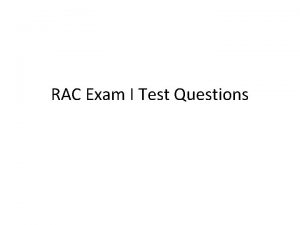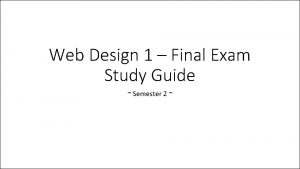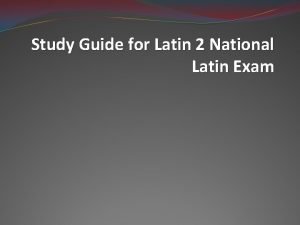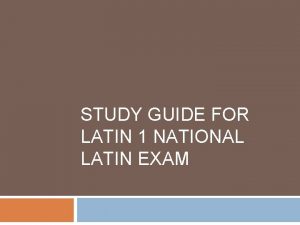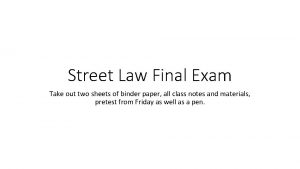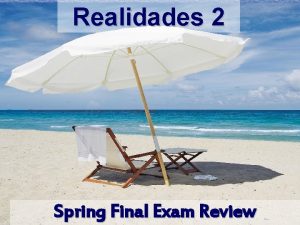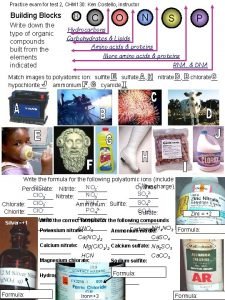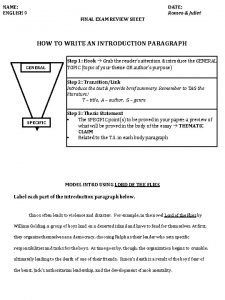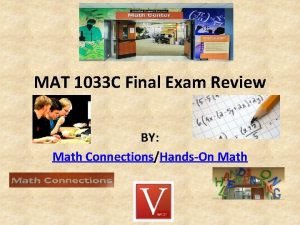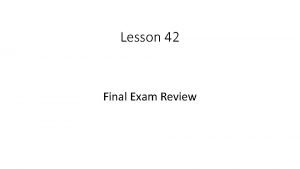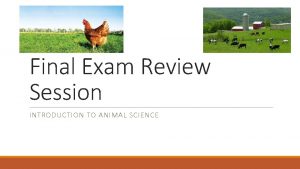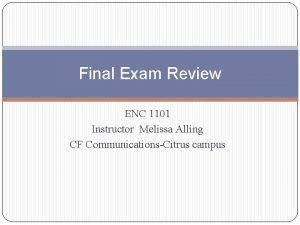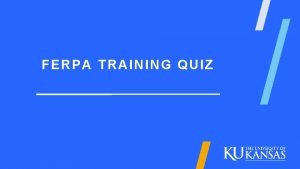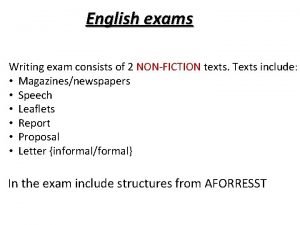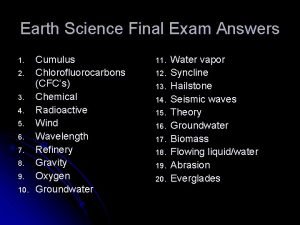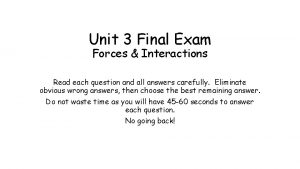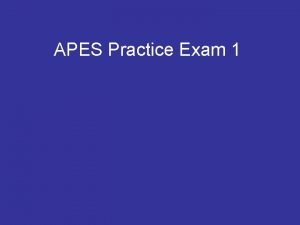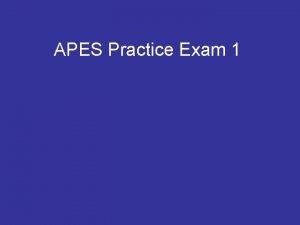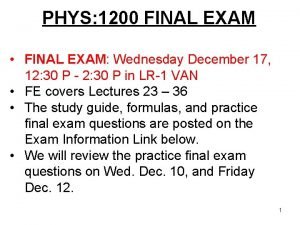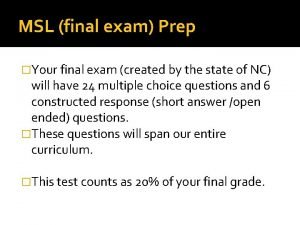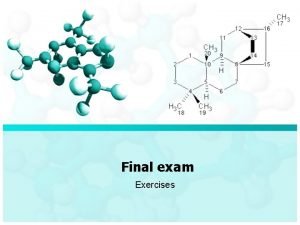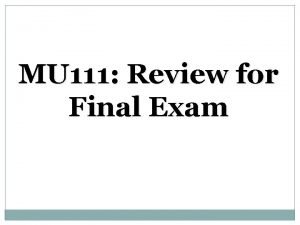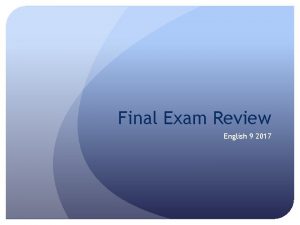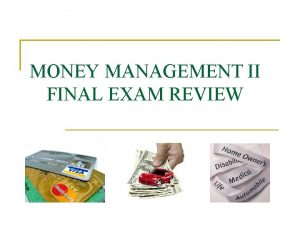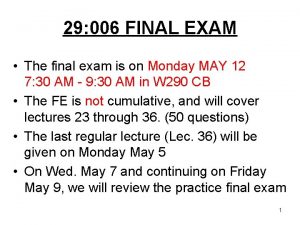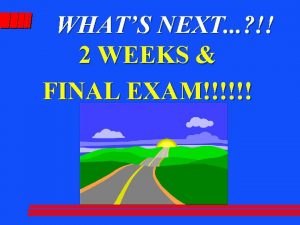Unit 1 Final Exam Practice Forces Interactions Questions










































- Slides: 42

Unit 1 Final Exam Practice Forces & Interactions Questions will be out of order on exam Don’t short cut your learning by only using the a, b, c, d, indicators. Always read the whole question and all answers because there are similar questions and answers on the exam. Good luck studying

MS-PS 2 -1 1. What is Newton’s third law of motion? a. Inertia b. The relationship between mass and acceleration. c. Action and reaction forces. d. Overcoming friction.

2. Objects in motion will ______ until acted upon by another force. a. remain in motion b. lose potential energy c. lose kinetic energy d. lose both potential and kinetic energy

3. Why do rockets move up toward space? a. Thrust is equal to gravity. b. Thrust is less than gravity. c. Thrust is greater than gravity. d. Gravity is greater than thrust.

4. Two gliders with the initial velocities and masses shown below hit each other in a perfectly elastic collision (elasticity 1. 0). What will the velocity of glider 2 be after the collision? a. 0 m/s. b. 2 m/s. c. 4 m/s. d. 6 m/s.

5. Glider 1 starts with a mass of 2. 4 kg and a velocity of 3. 0 m/s. What is Glider 1's starting momentum? a. 2. 4 kg • m/s b. 5. 4 kg • m/s c. 7. 2 kg • m/s d. 10. 8 kg • m/s

6. Given the starting conditions shown below and a perfectly elastic collision, what will be the total momentum of both gliders after they collide? a. -7. 0 kg • m/s b. -9. 0 kg • m/s c. -13. 0 kg • m/s d. -21. 0 kg • m/s

7. Two balls collide head-on on a table. The first ball has a mass of 0. 50 kg and an initial velocity of 12. 0 m/s. The second ball has a mass of 0. 75 kg and an initial velocity of -16. 0 m/s. After the collision, the first ball travels at a velocity of -21. 6 m/s. What is the velocity of the second ball after the collision? Assume a perfectly elastic collision and no friction between the balls and the table. a. 6. 4 m/s b. 11. 3 m/s c. 17. 8 m/s d. 21. 6 m/s

MS-PS 2 -2 8. Inertia is described by Newton’s ______. a. first law of motion b. second law of motion c. third law of motion d. law of gravitation

9. With a constant force, what will make acceleration decrease? a. Decrease the weight. b. Increase the weight. c. Increase the mass. d. Decrease the mass.

10. How could you increase the number of snowmen destroyed by the sled sliding down the hill? a. Increase the starting height of the sled. b. Increase the mass of the sled. c. Increase the starting kinetic energy of the sled. d. All of the above.

11. What might cause a car parked on a hill to start to roll backwards? a. An unbalanced force. b. A frictional force. c. A balanced force. d. An inertial force.

12. Find the net force on the object shown. a. 5 N b. 5 N c. 11 N d. 5 N

13. Find the net force on the object shown. a. 15 N b. 65 N c. 15 N d. 65 N

14. According to Newton’s second law of motion, what is the relationship between mass and acceleration? a. Inversely proportional to each other. b. If mass increases, acceleration increases c. Mass equals acceleration d. Proportional to each other.

15. What changes when an unbalanced force acts on a moving object? a. Speed b. Direction c. Neither speed nor direction d. Either speed or direction

16. Action forces and reaction forces are described by which of Newton’s Laws? a. First law of motion. b. Second law of motion. c. Third law of motion. d. The law of universal gravitation.

17. Balanced forces are always opposite in _______. a. direction b. size c. size and direction d. size or direction

MS-PS 3 -1 18. A 100 Kg man and 60 Kg woman both jump off a 10 meter platform to a pool below at the same time. Which answer below describes their relative speed and kinetic energy when they hit the water. (assume no air friction) a. The jumpers will both have a speed of 98 m/s, equal kinetic energy, and will hit the water at the same time. b. The man has more mass and he will have more kinetic energy, so he will be going faster than the smaller mass woman when they hit the water. c. The man will be going faster when he hits the water, but the same kinetic energy as the woman. d. Both will hit the water at the same time and same speed, but the man will have more kinetic energy due to a larger mass.

19. Based on the setup above, which of the following statements is true? a. The car will easily smash the egg. b. The car will just barely crack the egg. c. The car will touch the egg but won't break it. d. The car will never reach the egg.

20. Assuming there is no friction, which of the following is the reason for the correct answer to question #19 above? a. Potential energy converts to kinetic energy as the car moves forward allowing the car to reach and smash the egg. b. The car has just enough potential energy to get the car to the egg. c. The car starts at a lower height that the egg, so there is not enough gravitational potential energy to reach the egg. d. The car will transfer its kinetic energy to the egg and the egg will roll away.

21. Which of the following statements about the energy of a pendulum is true? a. The kinetic energy is always greater than both the potential energy and the total energy. b. The total energy is always greater than both the potential energy and the kinetic energy. c. The potential energy is always greater than both the kinetic energy and the total energy. d. All of the above may be true. e. None of the above are true.

22. Two 1 kg blocks are about to slide down frictionless inclined planes as shown below. Each block is 1 m high. Which statement is correct? a. Block A will have a greater final speed because it has more time to accelerate as it slides down the ramp. b. The two blocks will have the same final speed because they have the same potential energy at the beginning of the experiment and will have the same kinetic energy at the end. c. Block B will have a greater final speed because friction will have less time to slow it down. d. Block B will have a greater final speed because the steeper slope allows it to fall faster.

MS-PS 3 -5 23. Which of the following statements are true about energy and energy transfer? a. Energy is neither created nor destroyed, only transformed from one type to another. b. If you drop a ball, the ball will bounce to the same height that it was dropped from. c. Potential energy converts to kinetic energy as a roller coaster starts downhill, then back to potential energy as it goes back up. d. Both A and C are correct. e. None of these are correct.

24. The two sleds shown below are about to collide. If they stick together in the collision, what will happen after the collision? (In this collision, there is no friction between the sleds and the snow. ) a. The two sleds will move to the left. b. The two sleds will move to the right. c. The two sleds will be motionless in the middle. d. The sleds will move back and forth and never stop.

MS-PS 3 -2 25. The gravitational potential energy of an object is calculated by multiplying its mass times gravity times its height (PE=mgh). A 2 -kg block rests on a wall that is 3 m tall. What is the gravitational potential energy of the block on Earth? a. 3 joules b. 58. 8 joules c. 29. 4 joules d. 6 joules

26. An object of mass 1. 5 kg rests on a shelf where it has a gravitational potential energy of 7 joules. An object of mass 4. 5 kg is placed on the same shelf. What is the gravitational potential energy of this second object? (g=9. 8 m/s 2) a. 7 joules b. 10 joules c. 21 joules d. 31. 5 joules

27. If two magnets have like poles facing each other, they will ____. a. Neutral to each other b. Repel each other c. Attract each other d. Oppressed

28. A 1 -kg car and a 2 -kg car are both released from the top of the same hill and roll down a frictionless track. At the bottom of the hill, which car will have the greater speed? Which car will have the greater kinetic energy? a. The 1 -kg car will have greater speed, and the 2 -kg car will have greater kinetic energy. b. The 2 -kg car will have greater speed and the 1 -kg car will have greater kinetic energy. c. The cars will have equal speeds and equal kinetic energies. d. The cars will have equal speeds and the 2 -kg car will have greater kinetic energy.

MS-PS 2 -4 29. Which of the graphs above represents the relationship between the gravitational force that two objects exert upon one another and the distance between the two objects? a. Graph A. b. Graph B. c. Graph C. d. Graph D.

30. Two objects exert a gravitational force of 3 N on one another when they are 10 m apart. What would that force be if the distance between the two objects were reduced to 5 m? a. 1. 5 N b. 24 N c. 6 N d. 12 N

31. Two objects exert a gravitational force of 8 N on one another. What would that force be if the mass of BOTH objects were doubled? a. 2 N b. 32 N c. 16 N d. 4 N

MS-PS 2 -3 32. This type of magnet is activated by electric power. a. Lodestones b. Pieces of Magnetite c. Electromagnets d. Permanent Magnets

33. Why would lighting storms change the direction of a ship’s compass needle? a. A ship’s compass is powered by electricity. b. The electrical current in lightning generates a temporary magnetic field. c. Lightning demagnetizes magnets. d. A powerful electrical charge reverses the local magnetic field.

34. A magnetic levitation train floats on a _______ force above the track and goes very fast. a. Kinetic b. Magnetic c. Electronic d. Air

35. Which statement is true? a. Positively charged objects are attracted to other positively charged objects. b. Negatively charged objects are attracted to other negatively charged objects. c. Both A and B are true. d. None of the above are true.

36. While taking his clothes out of the dryer, Charles finds a sock clinging to his sweater. What is the best explanation for this common phenomenon? a. In the dryer, both the sock and the sweater lost electrons. b. In the dryer, both the sock and the sweater gained electrons. c. In the dryer, either the sock or the sweater gained electrons while the other item lost electrons. d. The cause of static cling is an unsolved scientific mystery.

MS-PS 2 -5 37. Which of the following is an example of an electrical insulator? a. Silver b. Copper c. Iron d. Rubber

38. Which object will be strongly attracted to a magnet? a. A wooden block. b. A car windshield. c. A refrigerator door. d. A person’s skin.

39. Two N-S magnets are glued to a sheet of paper. Iron filings are sprinkled, and the table is tapped several times. Which image matches what the filings should look like? a. Image A b. Image B c. Image C d. Image D

40. A wire carries a current of 10 amps. A researcher finds that the strength of the induced magnetic field at a certain point is 0. 50 G. What will the strength of the induced field be at the same point if the current is increased to 25 amps? a. 0. 20 G b. 0. 65 G c. 1. 00 G d. 1. 25 G

www. candretta. net Use the google form for the exam practice to see your grade on this practice exam.
 Hbs eoc review
Hbs eoc review English 9 final exam
English 9 final exam Physics fall final exam review
Physics fall final exam review Spanish 2 review
Spanish 2 review Hrm final exam
Hrm final exam Wipo dl 101
Wipo dl 101 Abfm certification exam
Abfm certification exam Rac exam
Rac exam World history spring final exam review answers
World history spring final exam review answers World geography spring final review
World geography spring final review Web design final exam
Web design final exam American history final exam
American history final exam Sbu final exam schedule
Sbu final exam schedule Latin 2 final exam answers
Latin 2 final exam answers National latin exam answers
National latin exam answers Street law final exam
Street law final exam Spanish 1 answer key
Spanish 1 answer key English 11 first semester exam
English 11 first semester exam What is the answer
What is the answer Human body systems final exam
Human body systems final exam Realidades 2 final exam
Realidades 2 final exam Chemistry 151 final exam
Chemistry 151 final exam Chm 130 chapter 12 practice problems answer key
Chm 130 chapter 12 practice problems answer key Poe practice test - materials answer key
Poe practice test - materials answer key Noah carried a skateboard
Noah carried a skateboard Romeo and juliet exam review
Romeo and juliet exam review Mat 1033 final exam review
Mat 1033 final exam review 42 final exam
42 final exam I am not contraction
I am not contraction Ied final exam
Ied final exam Hospitality and tourism final exam
Hospitality and tourism final exam World history semester 1 final exam
World history semester 1 final exam Animal science final exam
Animal science final exam Entrepreneurship 1 final exam review
Entrepreneurship 1 final exam review Enc 1101 final exam
Enc 1101 final exam Bm3final
Bm3final Safe schools training answers 2020 ferpa
Safe schools training answers 2020 ferpa End of semester test environmental science a edmentum
End of semester test environmental science a edmentum Creative nonfiction final exam
Creative nonfiction final exam World literature in english
World literature in english Earth science semester 2 final exam answers
Earth science semester 2 final exam answers Cs 1104 final exam
Cs 1104 final exam Cs 1101 programming fundamentals
Cs 1101 programming fundamentals







